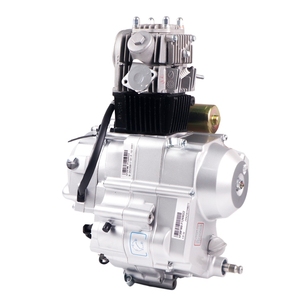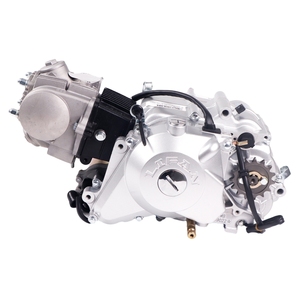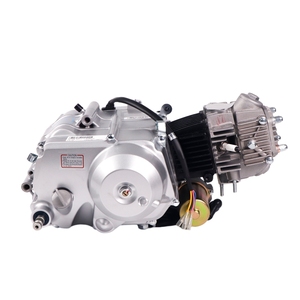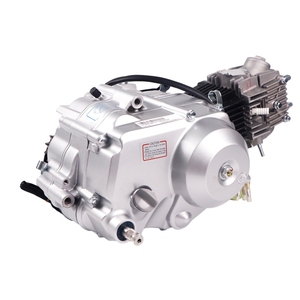(282 products available)





























































































































































































































Lifan motors are known for their durable and powerful engines. The brand offers a variety of engine types to meet different power and performance needs across various scooter models. Here are some common Lifan scooter engine types:
Gasoline Engines:
The most common engine in Lifan scooters is gasoline-powered. Gasoline engines are known for their quick acceleration and higher top speeds than other engine types. Besides, they have a more complex internal combustion process, which results in more power generation. Lifan gasoline engines are available in different displacements to suit various scooter models and performance levels. For instance, smaller scooters have 50cc or 125cc engines, while larger models have 150cc or 200cc engines.
Electric Motors:
Lifan has recently started producing electric scooters, featuring advanced electric motors. These electric motors provide instant torque, resulting in smooth and quick acceleration. The maintenance requirements of electric motors are also low, as they have fewer moving parts than combustion engines. Lifan electric motors are powered by high-capacity lithium batteries that provide a long range on a single charge. The batteries also support fast charging, which is convenient for urban commuters.
Hybrid Engines:
Some Lifan scooters feature hybrid engines that combine the benefits of gasoline engines and electric power. Hybrid engines have a gasoline engine that powers an electric generator. The electric generator provides additional power to the wheels, resulting in higher overall performance. Besides, hybrid engines have better fuel efficiency and lower emissions than conventional gasoline engines. Lifan hybrid engines are designed for high-performance scooters, offering a sporty ride.
Four-stroke Engines:
Lifan four-stroke engines are known for their stability and reliability, making them suitable for everyday use. The four-stroke engine completes four distinct strokes in each cycle: intake, compression, power, and exhaust. This design results in a smoother and quieter operation. Besides, four-stroke engines have higher fuel efficiency and lower emissions compared to two-stroke engines. Lifan four-stroke engines are available in various displacements to suit different scooter models and performance requirements.
Two-stroke Engines:
Lifan two-stroke engines are less common but still used in some older or smaller scooter models. The two-stroke engine completes two strokes for each cycle: intake-compression and power-exhaust. Two-stroke engines are simpler and lighter, which results in lower production costs. Besides, they have higher power-to-weight ratios, making them suitable for high-performance and racing scooters. However, two-stroke engines have higher emissions and lower fuel efficiency than four-stroke engines.
Engine type:
Four-stroke engines are the most common type of engine found in Lifan scooters. These engines are known for being very efficient and having low emissions. They are also very quiet and require little maintenance. Some Lifan scooters may have two-stroke engines, which are less common. Two-stroke engines are more powerful for their size but not as efficient as four-stroke engines.
Engine displacement:
Lifan scooters have a wide range of engine displacements, typically between 50cc and 150cc. This means that the engine size and power level vary from one scooter model to another. Scooters with larger engine displacements will be more powerful and able to go faster than those with smaller displacements. For example, a 150cc engine will provide more acceleration and a higher top speed compared to a 50cc engine.
Cooling system:
Some Lifan scooters use air-cooled engines, which means that the engine is cooled by the airflow as the scooter is riding. Other models may use water-cooled engines, where the engine is cooled by water flowing through pipes. Water-cooled engines tend to handle higher loads and extreme weather conditions better than air-cooled ones.
Fuel system:
Carburetors are used in Lifan scooter engines to mix air and fuel for combustion. The carburetor's adjustment affects how well the engine runs and how much power it produces. More recent Lifan scooter models may come with fuel-injected engines, which provide even better fuel efficiency and lower emissions compared to carbureted engines.
Ignition system:
Electric ignition systems, such as CDI (Capacitor Discharge Ignition) or TCI (Transistor Controlled Ignition), are used in Lifan scooter engines to provide a spark for combustion. These systems ensure that the engine starts and runs smoothly with a reliable spark.
Oil changes:
Regular oil changes are important to keep the Lifan scooter engine running smoothly. The oil should be changed every 1,000 km or at least every six months, even if the scooter is not used much. Be sure to use the type of oil recommended in the owner's manual. This helps lubricate engine parts and prevents damage. A new oil filter should also be installed at each oil change. This traps dirt and debris before the oil goes into the engine.
Air filter maintenance:
The air filter should be checked and cleaned every 1,000 km or at least every six months. A clogged air filter restricts airflow to the engine, making it work harder and reducing fuel efficiency. Remove the air filter from the scooter and tap it gently to remove loose dirt. It can also be rinsed in warm water with a few drops of dish soap. Be sure to let the filter dry completely before putting it back in the scooter.
Fuel system:
Use fresh gasoline with the recommended octane rating for the engine. Avoid using gas that has been sitting for more than six months, as this can cause starting issues. Adding a fuel stabilizer can help keep the fuel fresh if the scooter is not used for long periods. The fuel lines and tank should be inspected regularly for leaks or cracks. Replace any damaged parts to prevent fuel from leaking.
Cooling system:
If the Lifan scooter has a liquid-cooled engine, the coolant level needs to be checked regularly. Top up with the recommended type of coolant if the level is low. The coolant should also be changed according to the schedule in the owner's manual, usually every 20,000 km or every two years.
valve adjustments:
Valve clearances should be checked and adjusted as needed based on the schedule in the owner's manual. This ensures the engine runs smoothly and efficiently.
Tire maintenance:
Keep the tires properly inflated to the recommended pressure. Check the tire tread depth regularly and replace the tires when the tread is worn down.
Electrical system:
The battery terminals should be checked for tight connections and cleaned if there is corrosion. The battery should be charged regularly, especially if the scooter is not used often.
Overall maintenance:
Follow the maintenance schedule in the owner's manual for other services, such as spark plug changes, belt inspections, and brake adjustments. Taking care of these items on time helps prevent problems down the road.
Choosing the right Lifan scooter engine involves considering several factors to ensure that it meets the specific needs and requirements of the user or the business. Here are some of the factors to consider:
Engine displacement:
The engine displacement refers to the size of the engine, which is measured in cubic centimeters (cc). Lifan scooter engines come in different displacements, such as 50cc, 110cc, 125cc, 150cc, and 200cc. A larger engine displacement means more power and speed, while a smaller engine displacement offers better fuel efficiency and lower operating costs. Businesses need to consider the engine displacement based on the intended use of the scooter. For example, delivery services may require more powerful engines for faster deliveries, while rental services may opt for smaller engines for cost-effectiveness.
Fuel efficiency:
Lifan scooter engines are designed to be fuel efficient, which is advantageous for businesses that rely on fuel-powered scooters. Before choosing a Lifan scooter engine, it is important to consider the fuel consumption rate, which is usually expressed in liters per 100 kilometers (L/100km) or kilometers per liter (km/L). A more fuel-efficient engine will help reduce operational costs and minimize the environmental impact by lowering carbon emissions.
Maintenance and reliability:
Businesses need to consider the maintenance requirements and reliability of the Lifan scooter engines. Choose engines that require minimal maintenance and have readily available spare parts for quick repairs and servicing. Additionally, consider the engine's reliability track record based on other users' experiences and reviews.
Performance:
Consider the engine performance, including factors such as acceleration, top speed, and torque. Depending on the business needs, choose an engine that offers the required performance level.
Environmental regulations:
Different regions have specific environmental regulations regarding emissions and noise levels. Before choosing a Lifan scooter engine, ensure that it complies with the local environmental standards to avoid legal issues and penalties.
Load capacity:
For businesses that use scooters for delivery or transport services, consider the load capacity of the scooter. Choose engines that power scooters with the required load capacity to transport goods without compromising performance and safety.
Comfort and features:
Consider additional features and comfort aspects of the scooter, such as seating comfort, storage capacity, suspension system, and safety features. Depending on the business type, prioritize features that enhance comfort and convenience for the riders or customers.
Price and warranty:
Compare the prices of different Lifan scooter engines and consider the overall value concerning performance, fuel efficiency, and reliability. Additionally, check the warranty offered by the manufacturer to protect the investment and reduce repair costs.
Replacing a Lifan electric scooter engine can be a challenging task, as it requires knowledge of internal combustion engines and familiarity with mechanical components. However, here are some general steps that can be followed to replace a Lifan scooter engine:
Q1. How long does the Lifan engine last?
A1. The lifespan of the Lifan engine will depend on several factors. One of them is the level of wear and tear. An engine with low wear and tear will last longer compared to the one with high wear and tear. Another factor is the maintenance practices. Proper maintenance practices such as regular oil changes will increase the lifespan of the engine. Driving habits also have an impact on the lifespan of the engine. Engine lifespans will vary between Lifan engines.
Q2. What causes Lifan engine problems?
A2. Lifan engine problems will mainly be caused by mechanical issues, electrical issues, or fuel-related issues. The other main cause of engine problems is wear and tear. As the engine parts age, they become less efficient and may cause engine problems. Inexperienced mechanic and counterfeit spare parts are other causes of Lifan engine problems.
Q3. How can users prevent Lifan engine problems?
A3. To prevent Lifan engine problems, users should ensure that the engines are maintained regularly. They should also use quality fuel and ensure that the electrical system of the engine is intact. Driving the engine on smooth roads and avoiding overloading can also help in preventing engine problems.